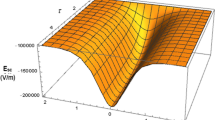Abstract
In a photovoltaic dissipative system, evolution and stability of a bright dissipative holographic photovoltaic (DHP) soliton are completely determined by the given dissipative system, i.e., they are impacted by the system parameters, such as the system temperature, the photovoltaic field of the crystal, the angle between two input beams, and the angle of polarized direction. Such DHP solitons can be easily amplified or absorbed by adjusting these system parameters. They have potential applications in optical switches or repeaters.
Similar content being viewed by others
References
Cohen O, Carmon T, Segev M, et al. Holographic solitons. Opt Lett, 2002,27(22): 2031–2033
Liu J S. Holographic solitons in photorefractive dissipative systems. Opt Lett, 2003, 28(22): 2237–2239
Liu J S. Existence and stability of rigid photovoltaic solitons in an open-circuit amplifying or absorbing photovoltaic medium. Phys Rev E, 2003 68(2): 026607-7
Liu S X, Liu J S, Zhang H L, et al. Diffusion-induced deflection and the effect of two-wave mixing gain on dissipative photovoltaic solition. Chin Phys, 2007, 16(5): 13911–1398
Segev M, Valley G C, Crosignani B, et al. Steady-state spatial screening solitions in photorefractive materials with external applied field. Phys Rev Lett, 1994, 73(24): 3211–3214
Akhmediev N N, Afanasjev V V, Soto-Crespo J M. Singularities and special soliton solutions of the cubic-quintic complex Ginzburg-Landau equation. Phys Rev E, 1996, 53(1): 1190–1201
Liu J S, Liang C H, An Y Y, et al. Anomalous temperature character of phase conjugation in doped-LiNbO3 crystal. Appl Phys Lett, 1995, 67(14): 2020–2021
Nouchi P, Partanen P J, Hellwarth R W. Temperature dependence of the electron mobility in photorefractive Bi12SiO20. J Opt Soc Am B, 1992, 9(8): 1428–1431
She W L, Lee K K, Lee W K. Observation of two-dimensional bright photovoltaic spatial solitons. Phys Rev Lett, 1999, 83(16): 3182–3185
Bosshard C, Mamyshev P V, Stegeman G I. All-optical steering of dark spatial soliton arrays and the beams guided by them. Opt Lett, 1994, 19(2): 90–92
Mamyshev P V, Bosshard C, Stegeman G I. Generation of a periodic array of dark spatial solitons in the regime of effective amplification. J Opt Soc Am B, 1994, 11(7): 1254–1260
Macuil R D, Castillo M D I. Waveguide properties of arrays of dark spatial solitons in a Bi12SiO20 photorefractive crystal. J Opt A-Pure Appl Opt, 2003, 5: S493–S499
Vaupel M, Seror C, Dykstra R. Self-focusing in photorefractive two-wave mixing. Opt Lett, 1997, 22(19): 1470–1472
Liu J S, Lu K Q. Screening-photovoltaic spatial solitions in biased photovoltaic photorefractive crystals and their self-deflection. J Opt Soc Am B, 1999, 16(4): 550–555
Valley G C, Segev M, Crosignani B, et al. Dark and bright photovoltaic spatial solitons. Phys Rev A, 1994, 50(6): R4457–R4460
Segev M, Valley G C, Bashaw M C, et al. Photovoltaic spatial solitions. J Opt Soc Am B, 1997, 14(7): 1772–1781
Liu J S, Wang C, Zhang H L, et al. Evolution and stability of holographic soliton pairs. Chin Sci Bull, 2006, 51(8): 1–6
Yeh P. Two-wave mixing in nonlinear media. IEEE J Quantum Electron, 1989, 25(3): 484–519
Oda I, Otani Y, Liu L, et al. Polarization effect for vibration detection using photorefractive two-wave mixing in KNSBN:Cu crystals. Opt Commun, 1998, 148: 95–1
Author information
Authors and Affiliations
Corresponding author
Additional information
Supported by the National Natural Science Foundation of China (Grant Nos. 10574051 and 10174025)
About this article
Cite this article
ShiXiong, L., JinSong, L., Xin, C. et al. Effects of system parameters on bright dissipative holographic photovoltaic solitons. Chin. Sci. Bull. 53, 1138–1144 (2008). https://doi.org/10.1007/s11434-008-0052-8
Received:
Accepted:
Published:
Issue Date:
DOI: https://doi.org/10.1007/s11434-008-0052-8




